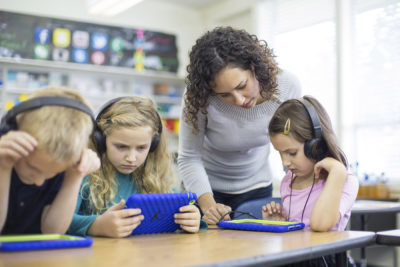“Embedding Digital Technologies into Classroom Practice to Accelerate, Amplify and Add Value to Learning.”
Using Digital Technology to Support Deeper Learning
This article deals with the second of the four design elements of the divisionâs Deeper Learning plan, Leveraging Digital. It is my hope that after reading this article, teachers will have a much clearer picture of what teaching and learning could look like in classrooms across the school division â when using the new educational technologies that are now available to teachers.
 In a recent Canadian Education Association article, Dr. Michele Jacobsen (Associate Dean, University of Calgary), who specializes in technology-enabled learning in both real-time and online writes, âCombining inquiry and technology opens the door to powerful new teaching and assessment practices that result in documented benefits for learners.â [1] Consistent with this focus, the HSD Deeper Learning plan will provide opportunity for teachers to work with school teams, PLNâs, and alongside Learning Coaches, to help them make the most of digital technologies when designing learning for students.
In a recent Canadian Education Association article, Dr. Michele Jacobsen (Associate Dean, University of Calgary), who specializes in technology-enabled learning in both real-time and online writes, âCombining inquiry and technology opens the door to powerful new teaching and assessment practices that result in documented benefits for learners.â [1] Consistent with this focus, the HSD Deeper Learning plan will provide opportunity for teachers to work with school teams, PLNâs, and alongside Learning Coaches, to help them make the most of digital technologies when designing learning for students.
So when the term âleveraging digitalâ comes up in a learning conversation, what does it mean? As a member of Michael Fullanâs global research project, New Pedagogies for Deeper Learning (NPDL), the ĩũ―ĖÉŦĮéÆŽ now has direct access to some great resources that can help us define the concept of âleveraging digitalâ. According to NPDL, leveraging digital identifies with the following: access to technology, personalization of learning, connecting and collaborating with others, real time assessment, feedback and reporting, authentic rich learning contexts, and connecting families with their childâs learning.
NPDL has developed an excellent rubric that describes the types of learning tasks teachers should be designing for their students, from an emerging to an advanced stage. At the emerging stage, learning tasks allow students to access timely and accurate learning feedback; enable learning anytime, anywhere with anybody; allow for individual and group work; and scaffold the learning processes to generate new digital learning artefacts. At the advanced stage, designing for learning (with technology) would be used to: iteratively and collaboratively inform and innovate on the use of digital to accelerate learning; and share new knowledge, processes and innovations within and beyond the classroom. [2]
What will student learning look like in technology-rich classrooms? In Chapter Six of the book, 21st Century Skills: Rethinking How Students Learn, Bob Pearlman provides a great definition of what learning with technology would mean in terms of student learning, âStudents utilize new technology tools as investigators and producers of knowledge.â[3] I believe that in many of our classrooms, teachers are already designing learning tasks in such a way that meets Pearlmanâs concept of 21st century learning where students, âfind the information they need through Internet research, but also through email communication and Skype video interviews with experts. Then, working individually or in a collaborative team, they construct products-models, booklets, videos, podcasts, websites, PowerPoints, digital portfolios and so on.â [4]
Where does a teacher start? Google of course! After typing in my search inquiry on leveraging digital technologies in classrooms, I came across a great website for teachers wanting to learn more about using technology in their lesson designs –. Scroll down the pages on the website and you will find links to: Chromebooks in schools; SAMR and Bloomâs Taxonomy; iPads in the Classroom; App for That; iPads for Teaching; and the list carries on. I felt like a kid in a candy story with a pocket full of coins and a smorgasbord of choices! Click on Chromebooks in the Classroom and you will find the following headings with links: Google Chromebook Tutorials; Chromebook Apps and Extensions; Information Chromebook Sites; and Successful Classroom Practices. This website can serve as an excellent starting point, and I hope it will stimulate some great discussion among teachers.
I hope that I have provided some clarity into what leveraging digital is all about and provided a really helpful link to some tremendous information, as we all work together to help design learning activities that will develop a culture within schools where students are investigators and producers of knowledge.
Sources:
[1] M. Jacobsen, âTeaching in a Participatory Digital Worldâ, Education Canada, Summer 2016, Vol 56, Issue 2. CEA website:
[2] New Pedagogies for Deeper Learning Global Partnership. âNew Pedagogies Learning Design Rubricâ. (2014)
[3] [4] Bellanca, J. A., & Brandt, R. S. (2010). 21st Century skills: Rethinking How Students Learn. Bloomington, IN: Solution Tree Press.
